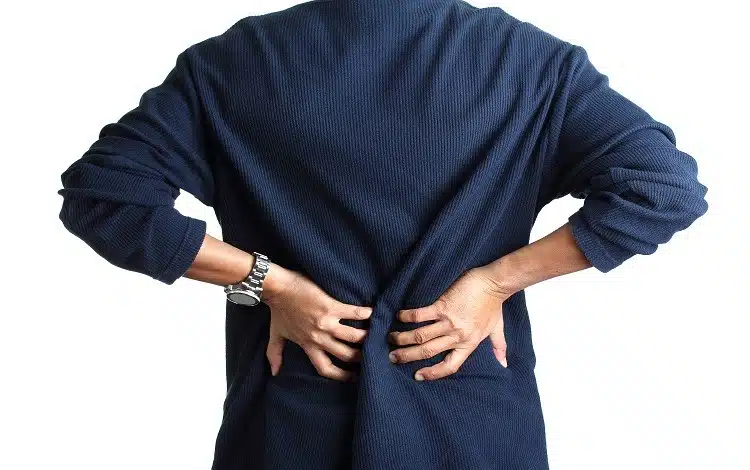In the grand journey of life, our backs often bear the weight of time, and for some, this manifests as lumbar spondylosis – a condition that affects the lumbar vertebrae, the lower portion of our spine. Lumbar spondylosis, the unwelcome guest, usually arrives after the age of 40, as our spine gracefully (or not so gracefully) ages, often leading to a chorus of degenerative issues in our vertebrae. This mischievous condition tends to favor the last two lumbar vertebrae (L4 and L5) and the sacral vertebra (S1).
A myriad of factors is responsible for this chronic condition, which includes aging, genetics, previous spine injuries, accidents, heavy lifting, excessive exercise, too much forward bending, extended computer-sitting sessions, and even those long two-wheeler rides that were supposed to be fun. Improper sleep postures and less-than-ideal bed choices for sleeping can also play a role in this spine condition.
Lumbar spondylosis isn’t just a single issue; as it often brings up multiple health issues including disc herniation, bulging discs, osteoarthritis, and bone spurs.
Some Common Symptoms of Lumbar Spondylosis:
- Increased pain after standing or traveling for too long
- Pain and numbness in the lower back
- Pain escalation when you dare to move your spine – say, lifting anything or bending
- That dreaded feeling of restricted movement
- Sleep troubles, fatigue, and anxiousness
- Muscle weakness in the legs
Lumbar Spondylosis – Treatments
When it comes to treating lumbar spondylosis, modern medical practice provides us with options like bed rest, belts or braces, nonsteroidal anti-inflammatory drugs (NSAIDs), spinal injections, physiotherapy, and in more severe cases, surgical intervention. While these lumbar spondylosis treatments have their merits, they do come with limitations, like NSAIDs causing stomach issues and taxing your kidneys and liver. Those belts, if worn for too long, could weaken your spinal muscles and potentially worsen the pain. Spinal injections, while offering relief, may have some steroid-related side effects, and surgeries, well, they’re not just expensive – they also come with their own set of risks, with some cases even experiencing increased pain afterward.
Enter Ayurveda, the ancient healing system that’s been around the block for centuries. In terms of Ayurveda, lumbar spondylosis has a familiar counterpart – Kati Vata, a type of Sandhigata Vata. Back pain in this scenario can be likened to Kati Shula Prishta Shula or Kati Graha. According to Ayurveda, an aggravation of the Vata dosha is often responsible for this pain and the degeneration of the lumbar spine. Things like excessive exposure to cold atmospheres, cold, dry, stale food, late-night owl behavior, and indulging in too much junk food can tip the Vata scales, intensifying the lumbar pain.
Ayurveda’s game plan revolves around balancing the Vata Dosha. Herbal medicines, Panchakarma, and Upakarmas (external therapies) come to the rescue, helping to relax muscles, reduce inflammation around the nerves, and promote healing.
Let’s take a sneak peek into Ayurvedic therapies for Lumbar Spondylosis:
Kati Basti
Imagine a cozy well of warm, medicated oil cradling your lower back. A dose of this liquid gold, retained for about 30-45 minutes, is like a soothing balm for your troubled back, keeping it lubricated and loved.
Abhyanga
This full-body and localized massage is like a symphony for your muscles, improving blood circulation and acting as gentle traction, creating more room between those vertebrae. It’s like yoga for your spine, stretching it out and easing the tension.
Swedana
A session of herbal bundle massage (patra pinda sveda), steaming (Bashpa sweda), or steaming using a pipe (nadi sweda) is like a spa day for your aching back. This divine fomentation reduces pain and stiffness, soothes those muscle spasms, and gets your blood flowing – perfect for musculoskeletal matters.
Basti
Enemas with medicated oil and herbal decoction may sound unconventional, but in Ayurveda, the large intestine is considered the Vata stomping ground (sort of). Basti plays a pivotal role in controlling the vitiated Vata of lumbar spondylosis, and it even nourishes your bones and muscles, helping you bounce back from those painful moments.
Taila or Dhanyamla Dhara
Medicated oil or fermented gruel, poured onto a specific area in a slow, rhythmic dance, is like a warm hug for your nerves, rejuvenating your muscles and boosting circulation. It’s like a gentle rain on parched earth, relieving stiffness, pain, and numbness.
Upanaha and Lepanam
Think of this as the soothing poultice, a paste applied to the affected area to ease pain, stiffness, and numbness. The warmth of this treatment does wonders for your blood circulation, like a cozy blanket for your troubled back.
So, there you have it – a blend of ancient wisdom and modern understanding, all aimed at easing the grip of lumbar spondylosis on your life. The healing journey involves balance, nourishment, and a dash of TLC for your spine. Whether it’s the soothing touch of Kati Basti or the rejuvenating embrace of Abhyanga, Ayurveda offers a roadmap to a more comfortable, pain-free existence. Lumbar spondylosis might be a common ailment, but it doesn’t have to disrupt your life. At Swasthya Ayurveda and Wellness Centre, our lumbar spondylosis treatment can offer you a natural path to relief, addressing the underlying causes while providing comfort to your aching back. By embracing Ayurvedic treatments, making healthier lifestyle choices, and seeking professional guidance, you can effectively manage lumbar spondylosis and enjoy a more pain-free existence.


